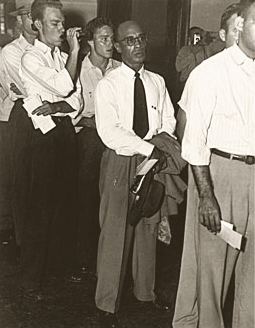Date decided 1950 | ||
 | ||
Citations 339 U.S. 629 (more)70 S. Ct. 848; 94 L. Ed. 1114; 1950 U.S. LEXIS 1809 Prior history Cert. to the Supreme Court of Texas Majority Vinson, joined by unanimous Similar McLaurin v Oklahoma State Reg, Missouri ex rel Gaines v Canada, Sipuel v Board of Regents, Buchanan v Warley, Davis v County School B | ||
Sweatt v painter
Sweatt v. Painter, 339 U.S. 629 (1950), was a U.S. Supreme Court case that successfully challenged the "separate but equal" doctrine of racial segregation established by the 1896 case Plessy v. Ferguson. The case was influential in the landmark case of Brown v. Board of Education four years later.
Contents
The case involved a black man, Heman Marion Sweatt, who was refused admission to the School of Law of the University of Texas, whose president was Theophilus Painter, on the grounds that the Texas State Constitution prohibited integrated education.
Sweatt v painter
Procedural history
The state district court in Travis County, instead of granting the plaintiff a right of mandamus, continued the case for six months. This allowed the state time to create a law school only for black students, which it established in Houston, Texas, rather than in Austin. The 'separate' law school and the college became the Thurgood Marshall School of Law at Texas Southern University (known then as "Texas State University for Negroes").
The trial court decision was affirmed by the Court of Civil Appeals and the Texas Supreme Court denied writ of error on further appeal. Sweatt and the NAACP next went to the federal courts, and the case ultimately reached the U.S. Supreme Court. Robert L. Carter and Thurgood Marshall presented Sweatt's case.
U.S. Supreme Court
The Supreme Court reversed the lower court decision, saying that the separate school failed to qualify, both because of quantitative differences in facilities and experiential factors, such as its isolation from most of the future lawyers with whom its graduates would interact. The court held that, when considering graduate education, experience must be considered as part of "substantive equality." The documentation of the court's decision includes the following differences identified between white and black facilities:
Legacy
On June 14, 2005, the Travis County Commissioners voted to rename the courthouse as The Heman Marion Sweatt Travis County Courthouse in honor of Sweatt's endeavor and victory.
